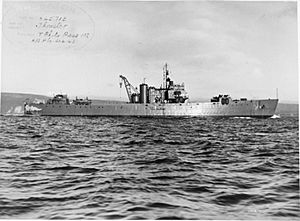HMS Thruster (F131) facts for kids
HMS Thruster (F131) was a special kind of ship called a Mark I LST. It was built by Harland and Wolff in the United Kingdom.
The ship was launched in September 1942 and started service in March 1943. It played an important role during World War II. Thruster helped the Allied forces in their invasion of Italy.
Contents
Ship Design and Features
The Thruster was the third ship of its kind, known as the LST Mk.1 class. LST stands for Landing Ship, Tank. These ships were designed to carry many vehicles and soldiers directly onto beaches.
What Could Thruster Carry?
Thruster was a very strong ship. It could carry:
- 13 Churchill tanks
- 27 other vehicles
- 193 soldiers
Speed and Special Ramp
This ship was quite fast, even when it was full of cargo. It could travel at about 18 knots (about 33 kilometers per hour). This speed was important for quick landings during battles.
However, Thruster could not go into very shallow water easily. Because of this, it had a special ramp at the front. This ramp was about 140 feet (43 meters) long. It allowed tanks and vehicles to drive off the ship directly onto the beach.
Other LST Designs
There were only two other ships like Thruster. Plans to build more LSTs in the United States led to a different design. The new design was simpler and could carry a similar amount of cargo. It also had a much shallower bottom, which made it easier to land on beaches.
Thruster served bravely in the Royal Navy during World War II. It was involved in several major operations.
Italian Campaign
In 1943, Thruster took part in the Salerno landing. This was a key part of the Allied invasion of Italy. The ship helped bring troops and equipment ashore.
Normandy Landings Role
In 1944, Thruster was changed into a fighter direction ship. This meant it could help control fighter planes from the sea. It guided these planes using radar during the famous Normandy landings. This was important for protecting the invasion forces.
Post-War Service
Later in 1944, after its wartime duties, Thruster helped British troops. It took them back to Athens, the capital city of Greece. In 1947, the ship was transferred to the Royal Netherlands Navy.
After being transferred in 1947, Thruster joined the Royal Netherlands Navy. It was given a new name: HNLMS Pelikaan. Its new hull number was A 830. The ship continued its service under this new name until it was scrapped in Bilbao in 1973.
See also


